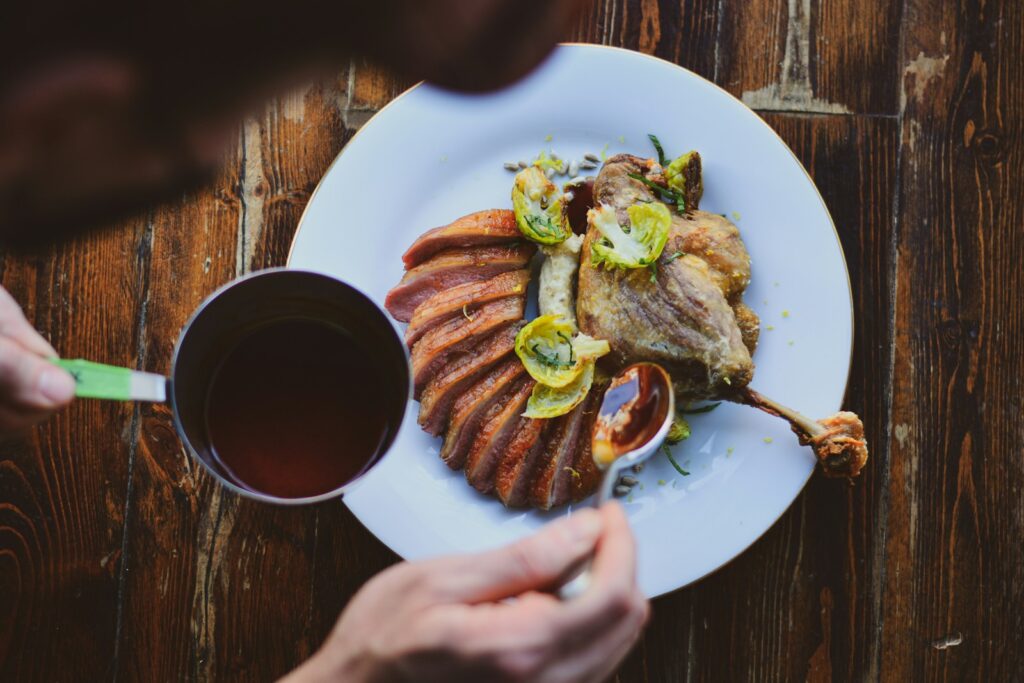Have you ever stood in the quiet solace of the woods, with nothing but the rustle of leaves and your own breath for company, and thought about the journey from the thrill of the hunt to the warmth of a shared meal? Perhaps, like me, you’ve felt the weight of responsibility that comes with harvesting nature’s bounty. My personal journey with waterfowl hunting has been filled with learning and adaptation, especially when it came to transforming the catch of the day into a meal that brings friends and family together around the dinner table.
The challenge of enjoying the fruits of a hunt, particularly with ducks, is one that I’ve grappled with for years. Despite my love for the sport and the deep respect I have for nature, the transition from hunter to chef was not a seamless one. Ducks, with their rich, gamey flavor, often left me and my fellow hunters pondering over how to best prepare them. It was a matter of palate, of course. The intense flavor that defines wild duck was too much for some to savor.

Through countless conversations with fellow enthusiasts and years of trial and error, I stumbled upon a revelation that changed everything: a simple brine. The method might seem rudimentary to some, but its effectiveness in transforming the taste of duck is nothing short of miraculous. It turns out, the way to everyone’s heart (and stomach) was through a process as ancient as cooking itself. The brine, a straightforward concoction of water and salt, became my secret weapon.
Brining transforms meat, not just soaking it in salty water.
It draws out blood and impurities, mellows the gamey flavor, and tenderizes the meat. The beauty of this method lies in its simplicity and versatility. Whether you choose to add extra flavors to the brine or stick to the basics, the outcome is invariably delicious. The preparation requires some foresight and patience – the brine must be cooled before adding the duck, and the meat needs to soak for the right amount of time – but the result is worth the wait.
Every hunter respects the game in the field and in the kitchen.
By taking the time to properly brine and prepare the duck, we honor the life that has been given. This process, from the careful cooling and waiting to the final rinse before cooking, is a ritual in its own right. It’s a testament to the respect we hold for the natural world and the sustenance it provides.
On my way from marshes to kitchen, I’ve found joy in hunting through shared experiences.
The act of cooking, of transforming what we’ve harvested with our own hands into nourishment, is profoundly rewarding. It bridges the gap between the wild and our tables, creating a connection that goes beyond the plate. As we move forward, let’s dive into the recipe that epitomizes this journey – a dish that marries the richness of duck with the sweetness of apples in a celebration of harvest, tradition, and community.
After having laid the groundwork with our carefully brined duck, let’s move on to the pièce de résistance: crafting the ultimate dish of sliced duck breast with flambéed apple slices, affectionately known as “Ducks in the Orchard.”
This meal is a blend of fall flavors and communal dining.
It’s a celebration of both the game that has been skillfully harvested and the seasonal bounty of apples, coming together in a dish that’s as beautiful to look at as it is to eat. So, grab your apron, because we’re about to embark on a culinary adventure that will delight your senses and impress your guests.
The first step in creating “Ducks in the Orchard” involves the duck breasts themselves. After they have been lovingly brined, as we’ve discussed, it’s crucial to bring them to room temperature before cooking. This ensures that they cook evenly and retain their moisture, resulting in succulent, tender meat. Lightly salt the duck breasts and let them sit, allowing them to acclimate. This is a moment of anticipation, a brief pause in the kitchen where one can reflect on the journey from field to fork. Let’s talk about the apples. Choosing the right type, like Jonagold or Fuji, is crucial for enhancing the duck’s flavor. Slice them, soak in lemon water to keep fresh, and add a hint of zest.
As the apples are prepped, it’s time to turn our attention to the pan. A large saute pan is heated, and then duck fat or butter is added to swirl and coat the pan. This is where the magic happens. The duck breasts are placed skin side down, and the kitchen fills with the sizzling sound of cooking, a promise of the delicious meal to come. The skin crisps up to a beautiful golden brown, a testament to the patience and care that went into its preparation.
But the real showstopper is the flambéed apple slices. Once the duck is cooked and resting, the apple slices are sautéed in the same pan, soaking up all those delicious flavors. A sprinkling of brown sugar caramelizes the apples, creating a glistening coating that’s simply irresistible. Then, with a flourish, apple cider is added, and the pan is deglazed, lifting all those succulent browned bits into a sauce that’s rich and complex.

To assemble the dish, slices of duck breast are arranged with the caramelized apples in a pattern that’s as aesthetically pleasing as it is appetizing. A final drizzle of the reduced cider sauce over the top adds a glossy finish that makes the dish sparkle. And there you have it, “Ducks in the Orchard” – a dish that’s not just a meal, but a masterpiece.
“Ducks in the Orchard” is more than just a recipe; it’s an experience. It’s a testament to the joy of cooking, the art of preparation, and the celebration of harvest. Whether it’s a special occasion or a simple gathering of friends and family, this dish promises to bring smiles, satisfaction, and a sense of connection to those who partake in it. So, here’s to the hunters, the gatherers, the cooks, and everyone in between – may your tables always be filled with good food, laughter, and love.
Related posts:
A Simple Brine Can Make Almost Any Duck Delicious
Duck with Apples Recipe – Duck Breast with Apples
Pan Seared Duck Breast Recipe with Cooked Apple Compote





